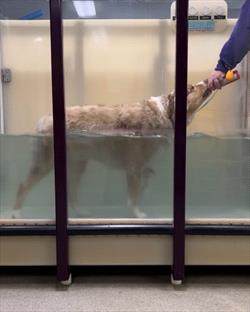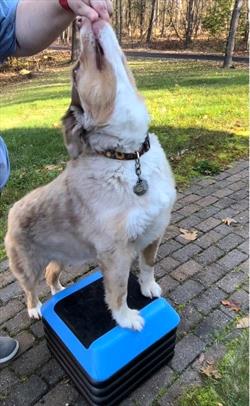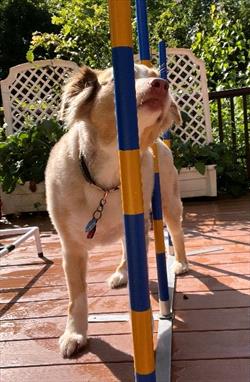Q: My dog has recently started rehab for hip dysplasia and seems stressed. Is there anything I can do to make him more comfortable?
A: Always consult with your vet and a certified canine rehabilitation therapist to create a customized plan for your dog. They can guide you in using appropriate exercises and techniques for your dog’s medical needs. Monitor your pet carefully during the exercises and the rest of the day for fatigue, pain, or stress. Ways to minimize stress and make the experience beneficial for your dog include:
1. Use only appropriate equipment, such as therapy balls, Cavaletti, weave poles, balance pads, or underwater treadmills, as recommended by a professional. Ensure that the equipment is safe and properly adjusted for your dog’s size and condition.
2. Incorporate fun and play when appropriate using positive reinforcement. This rewards your dog for desired behaviors, reduces stress, and keeps them engaged. Toys help encourage movement while offering treats during and after exercises can keep them motivated. Use licking mats in underwater treadmills and during stretching routines. End each session with praise and a gentle massage to reinforce the human-animal bond and work those sore muscles.
3. Start with a comfortable, quiet environment. Minimize distractions and loud noises as much as possible, whether in your home or a rehabilitation facility. This is as much for your dog’s stress as it is for you to focus on your dog’s overall comfort, both emotionally and physically. The temperature of the room and in the underwater treadmill should be comfortable as well. In your home, designate an area or a room with their equipment so this becomes a predictable routine and space for them.
4. Supervise your dog closely during the workout to ensure they are performing exercises correctly. Monitor your dog’s body language carefully. If they appear anxious, fatigued, or in pain, stop the session and consult immediately with your veterinarian or physical therapist to avoid further stress and potential complications.
5. Use assistive devices, such as harnesses or slings, when needed, especially if your dog is struggling with mobility. These devices can reduce stress on their joints and muscles.
6. Begin the rehabilitation process slowly, introducing only a few exercises at a time. Practice each for just a few minutes throughout the day instead of long, intense sessions. This can help your dog feel more comfortable and engaged without overwhelming them. Offer plenty of breaks during and between each repetition as your pet needs. Gradually increase the duration of both the exercises and sessions as your dog becomes more comfortable with each exercise.
7. Maintain a regular daily routine as much as possible. This can help reduce stress by providing a sense of familiarity and predictability.
Rehabilitation can take time, and some days may be more challenging than others. Remember that every dog is unique, and their response to rehab may vary. Be flexible and adjust your approach based on your dog’s individual needs and progress. Always seek guidance from a professional to ensure you are providing the most appropriate care for your pet. Be patient and support your dog throughout their journey.







